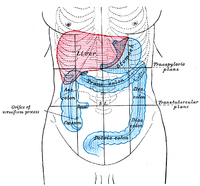
Photo from wikipedia
AIM This study aimed to compare the morphometric characteristics of the foramen ovale (FO) and rotundum (FR) and their localization in the middle cranial fossa in head and neck computed… Click to show full abstract
AIM This study aimed to compare the morphometric characteristics of the foramen ovale (FO) and rotundum (FR) and their localization in the middle cranial fossa in head and neck computed tomography images in patients with trigeminal neuralgia (TN) and asymptomatic individuals. MATERIAL AND METHODS FO and FR length, width and area parameters were examined in 158 asymptomatic individuals and 19 patients with TN. Their location in the middle cranial fossa was determined according to the sagittal (y) axis passing through the middle of the dorsum sella and connecting the foremost point and the rearmost point of the skull, and the transverse (x) axis passing through the middle of this axis. In comparisons with asymptomatic individuals, data on the painful side of patients with trigeminal neuralgia were used. RESULTS The mean width of the FO and its distance from the transverse axis were determined 3.36±0.79 mm and 1.44±0.39 mm in asymptomatic individuals, 2.88±0.83 mm and 1.23±0.45 in TN patients, respectively. These FO parameters were statistically significantly smaller in patients with TN. In asymptomatic individuals, while the mean width of the FR was determined to be 2.05±0.48 mm, the mean length was 2.14±0.47 mm, and its distance to the transverse axis and sagittal axis was found to be 2.65±0.35 mm and 1.96±0.25 mm, respectively. In patients with TN, while the mean width of the FR was revealed to be 1.77±0.46 mm, the mean length was 1.78±0.42 mm, and its distance to the transverse axis and sagittal axis was found to be 2.33±0.40 mm and 1.87±0.16 mm, respectively. These FR parameters were statistically significantly smaller in patients with TN. CONCLUSION The fact that the dimensions of the FO and FR and their distances to the sagittal and transverse axes were statistically significantly smaller in patients with TN suggested that it may be one of the causes of TN.
Journal Title: Turkish neurosurgery
Year Published: 2021
Link to full text (if available)
Share on Social Media: Sign Up to like & get
recommendations!